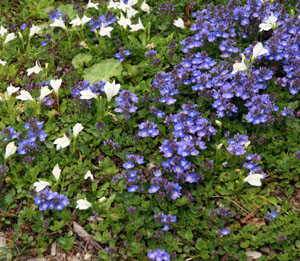
There are many species of speedwell – the genus Veronica, in the figwort or snapdragon family (Scrophulariaceae) – that are worthy garden plants. Several of these species are very low-growing types that make excellent ground covers.
These species need a sunny spot in well drained soil and do best in poor, rocky soils. Because they do not tolerate wet conditions during the winter, use low-growing Veronica species in the rock garden, as a ground cover in dry gardens, in raised beds or in troughs.
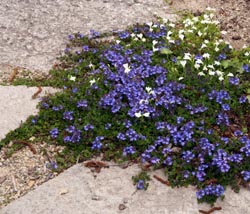
Planted between paving bricks or flagstone, they will fill in the cracks with attractive flowers and foliage. Use them to form a green carpet beneath dwarf conifers and as a filler creeping over rocks and between other taller plants. Flowering is best with limited water and full sun.
The species can be grown from seed sown in spring on the soil surface, while hybrids and cultivars are best propagated from cuttings taken in late spring and early summer, just after flowering. Plants can be sheared after flowering to keep them looking tidy. They are not favored by deer or rabbits.
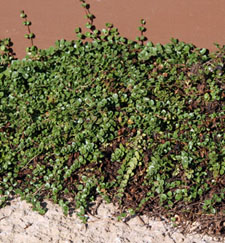
Veronica oltensis (once incorrectly named V. telephifolia f. incissa), or thyme-leaf speedwell, is a very low-growing species with many different uses in the landscape. Native to rocky slopes at high altitudes in the rugged mountains of Turkey, this is a tough plant hardy in zones 4-9.
Thyme-leaf speedwell is slow-growing, long-lived and drought tolerant, forming a mat up to 24” wide and less than an inch high. With its tiny, dark green leaves on trailing stems, this species resembles creeping thyme, but there is no fragrance. Pinnate, slightly hairy leaves cover the stems which reach upward as they trail. The evergreen plants always look nice but are particularly attractive when flowering. Small blue flowers cover the plant when it is in bloom in late spring or early summer. The individual flowers are about 3/8 inch across and borne in erect racemes. Flower color ranges from sky blue to bright azure to dark violet blue. The almost-lacy-looking foliage has a delicate texture that contrasts nicely with many other plants.
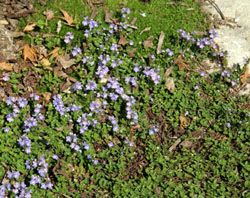
V. liwanensis, Turkish speedwell, is a similar low-growing species with purplish-blue flowers in spring. Plants grow 1-2″ tall and spread to 18″ wide. It is vigorous and quick-growing, with round, glossy evergreen leaves. The prostrate stems root as they elongate, forming a dense carpet. The small but numerous, bright blue flowers bloom in late spring but may also rebloom lightly later in the summer. This species was a 1997 Plant Select® winner* and is hardy in zones 3-8.
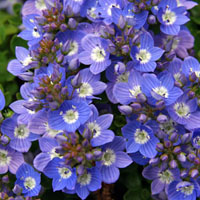
Veronica ‘Blue Reflection’ is a hybrid of V. liwanensis and V. pectinata, or blue woolly speedwell. It has the profuse, true-blue flowers of V. liwanensis and the heat tolerance and vigor of V. pectinata. It blooms a bit later than either parent. This plant gets about 3″ high and will fill in spots quickly. It also forms a dense mat and is hardy in zones 4-9.
There are several other low-growing species that are hardy in our region and remain under 3″ tall including V. armena, V. caespitosa v. caespitosa (pink flowers), V. cunifolia ssp. issaurica, V. guthriana, V. kotschyana, V. pectinata (white or pink), V. prostrata, V. pseudocinerea, several varieties of V. rupestris (some with white or pink flowers), and V. spicata ‘Blue Carpet’ and ‘Nana’. Most have blue flowers but a few have white or pink flowers.
– Susan Mahr, University of Wisconsin – Madison
Ask Your Gardening Question
If you’re unable to find the information you need, please submit your gardening question here:





 Aster, Symphyotrichum spp.
Aster, Symphyotrichum spp. Fascinating Fasciation
Fascinating Fasciation Alternatives to Lawn: Groundcovers
Alternatives to Lawn: Groundcovers Marigolds
Marigolds


